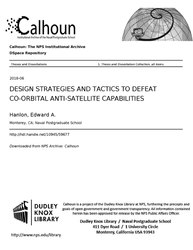File:DESIGN STRATEGIES AND TACTICS TO DEFEAT CO-ORBITAL ANTI-SATELLITE CAPABILITIES (IA designstrategies1094559677).pdf

Original file (1,275 × 1,650 pixels, file size: 8.05 MB, MIME type: application/pdf, 104 pages)
Captions
Captions
Summary[edit]
| DESIGN STRATEGIES AND TACTICS TO DEFEAT CO-ORBITAL ANTI-SATELLITE CAPABILITIES
( |
||
|---|---|---|
| Author |
Hanlon, Edward A. |
|
| Title |
DESIGN STRATEGIES AND TACTICS TO DEFEAT CO-ORBITAL ANTI-SATELLITE CAPABILITIES |
|
| Publisher |
Monterey, CA; Naval Postgraduate School |
|
| Description |
Spacecraft play an increasingly significant role in U.S. military operations. For adversaries looking to degrade U.S. capability to mitigate tactical advantage, this reliance provides another attack vector and represents a potential U.S. weakness. Recent technological developments have resulted in the increased proliferation of “attack” satellites. A strong understanding of the orbital domain and orbital dynamics is necessary to effectively evade these attackers. Much like the early days of aviation, space innovation has outpaced existing tactics, techniques and procedures. This thesis aims to provide an overview of the domain and possible evasive maneuvers to facilitate further tactics development. It begins with an overview of the threat landscape to provide background on what to expect and proceeds to discuss what positions of advantage are in space and how thrust commands translate to maneuvers at different time scales. It details the development of an engagement simulator and provides insight as to the effect of various evasion thrust patterns. From this, an evasion tactic is developed and tested in the simulator. This tactic proves effective in evading an aggressor while also demonstrating substantial fuel savings over alternative methods. Finally, different spacecraft parameters are compared to determine what hardware improvements provide the best evasive capability. Subjects: satellite; evasion; survivability; anti-satellite; defense; co-orbital; space; maneuver |
|
| Language | English | |
| Publication date | June 2018 | |
| Current location |
IA Collections: navalpostgraduateschoollibrary; fedlink |
|
| Accession number |
designstrategies1094559677 |
|
| Source | ||
| Permission (Reusing this file) |
This publication is a work of the U.S. Government as defined in Title 17, United States Code, Section 101. Copyright protection is not available for this work in the United States. | |
Licensing[edit]
| Public domainPublic domainfalsefalse |
This work is in the public domain in the United States because it is a work prepared by an officer or employee of the United States Government as part of that person’s official duties under the terms of Title 17, Chapter 1, Section 105 of the US Code.
Note: This only applies to original works of the Federal Government and not to the work of any individual U.S. state, territory, commonwealth, county, municipality, or any other subdivision. This template also does not apply to postage stamp designs published by the United States Postal Service since 1978. (See § 313.6(C)(1) of Compendium of U.S. Copyright Office Practices). It also does not apply to certain US coins; see The US Mint Terms of Use.
|
 | |
| This file has been identified as being free of known restrictions under copyright law, including all related and neighboring rights. | ||
https://creativecommons.org/publicdomain/mark/1.0/PDMCreative Commons Public Domain Mark 1.0falsefalse
File history
Click on a date/time to view the file as it appeared at that time.
| Date/Time | Thumbnail | Dimensions | User | Comment | |
|---|---|---|---|---|---|
| current | 16:50, 16 July 2020 |  | 1,275 × 1,650, 104 pages (8.05 MB) | Fæ (talk | contribs) | FEDLINK - United States Federal Collection designstrategies1094559677 (User talk:Fæ/IA books#Fork8) (batch 1993-2020 #13515) |
You cannot overwrite this file.
File usage on Commons
The following page uses this file:
Metadata
This file contains additional information such as Exif metadata which may have been added by the digital camera, scanner, or software program used to create or digitize it. If the file has been modified from its original state, some details such as the timestamp may not fully reflect those of the original file. The timestamp is only as accurate as the clock in the camera, and it may be completely wrong.
| Short title | DESIGN STRATEGIES AND TACTICS TO DEFEAT CO-ORBITAL ANTI-SATELLITE CAPABILITIES |
|---|---|
| Image title | |
| Author | Hanlon, Edward A. |
| Software used | Hanlon, Edward A. |
| Conversion program | pdfTeX-1.40.17 |
| Encrypted | no |
| Page size | 612 x 792 pts (letter) |
| Version of PDF format | 1.4 |

